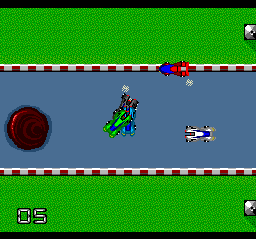~ MOTO ROADER ~
NCS/Masaya
HuCard
1989
The first thing that came to mind when I started playing this was Legend of Dekoboko, another "car combat" game that insists on having all five racers on screen at all times and smacks the bottom feeders forward when they fall too far behind. The memories of Dekoboko caused me much stress and vexation, as I did not enjoy that game. But I soon discovered that MR is a far cry from the debacle that is LoD.
Instead of walloping you with the edge of the screen and causing spin-out chains like Dekoboko does when you're trailing, MR simply gives you an oftentimes helpful little nudge that can be implemented tactically if you're willing to take some chances. And MR knows what it is, it knows what makes itself tick. Dekoboko is a failed attempt at cuteness, trying so hard to incorporate "wacky" things that it ends up being a slow, annoying obstacle-course run. MR, on the other hand, concentrates on providing simple, fast-paced fun.
It provides plenty of moments that'll "bring a smile to your face," like when you make a big jump and see your auto bouncing on the pavement and speeding on ahead of the pack, or when you avoid a slick spot that trips up all of your opponents, or when you pull off a last-second miracle at the finish line thanks to some crazy mishap that befalls the other drivers.
Also, the snazzy soundtrack is surprisingly good. Props to Goblin Sound!
I've read complaints about the one-player mode, and most of them involve the "high" level of difficulty due to the car being "too slow" at first. I don't know what the hell these people were expecting at the beginning of a game with purchasable upgrades--a speedster right off the bat? Hell, the game even gives you enough money so that you can upgrade your engine immediately if you want to, so I'd say it's more than fair in this regard.
I've also heard some gripes about the controls, and they are indeed different from what you encounter in most racers, but spend an afternoon with the game and you'll have them mastered if you're competent.
So do buy the game if you aren't a bumbling fool. But bear in mind that there are actually some differences between the US and Japanese renditions. For one thing, to access different courses in the JPN game, you have to input various button combinations at the title screen, whereas the US version just presents them all on a convenient menu, no codes required.
The US chip also features extra background art during the pre-heat and trophy ending scenes, along with a different chick (though, unfortunately, neither one of these girls is particularly pleasant to take a gander at).
Both cards contain more than just a single ending image that you can view, though you do see only one each time you play through the game, and the one you end up with seems like a totally random thing.
The US version fails to give special thanks to SCHBIBIN MAN in the end credits though. For shame.









No comments:
Post a Comment